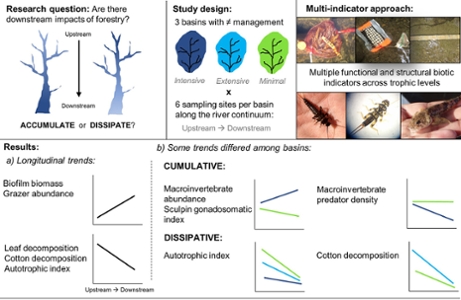Forest management impacts on stream integrity at varying intensities and spatial scales: Do biological effects accumulate spatially?
Author: Erdozain M., Kidd K.A., Emilson E.J.S., Capell S.S., Luu T., Kreutzweiser D.P., Gray M.A.
Posted on Apr 8, 2021
Category: Publications , Research
Abstract: The effects of forest harvesting on headwaters are quite well understood, yet our understanding of whether impacts accumulate or dissipate downstream is limited. To address this, we investigated whether several biotic indicators changed from smaller to larger downstream sites (n = 6) within three basins that had intensive, extensive or minimal forest management in New Brunswick (Canada). Biofilm biomass and grazer abundance significantly increased from upstream to downstream, whereas organic matter decomposition and the autotrophic index of biofilms decreased. However, some spatial trends differed among basins and indicated either cumulative (macroinvertebrate abundance, predator density, sculpin GSI) or dissipative (autotrophic index, cotton decomposition) effects downstream, potentially explained by sediment and nutrient dynamics related to harvesting. No such among-basin differences were observed for leaf decomposition, biofilm biomass, macroinvertebrate richness or sculpin condition. Additionally, results suggest that some of the same biological impacts of forestry observed in small headwaters also occurred in larger systems. Although the intensive and extensive basins had lower macroinvertebrate diversity, there were no other signs of biological impairment, suggesting that, overall, current best management practices protect biological integrity downstream despite abiotic effects.
Authors:
Author affiliations:
1 Canadian Rivers Institute and Biology Department, University of New Brunswick, 100 Tucker Park Road, Saint John, New Brunswick E2L 4L5, Canada.
2Department of Biology, School of Earth, Environment and Society, McMaster University, 1280 Main St. W., Hamilton, Ontario L8S 4K1, Canada.
3 Natural Resources Canada, Canadian Forest Service, Great Lakes Forestry Centre, 1219 Queen St. East, Sault Ste. Marie, Ontario P6A 2E5, Canada.
4 Canadian Rivers Institute, Faculty of Forestry and Environmental Management, University of New Brunswick, 28 Dineen Drive, Fredericton, New Brunswick E3B 5A3, Canada.
To read the entire article go to doi: 10.1016/j.scitotenv.2020.144043

